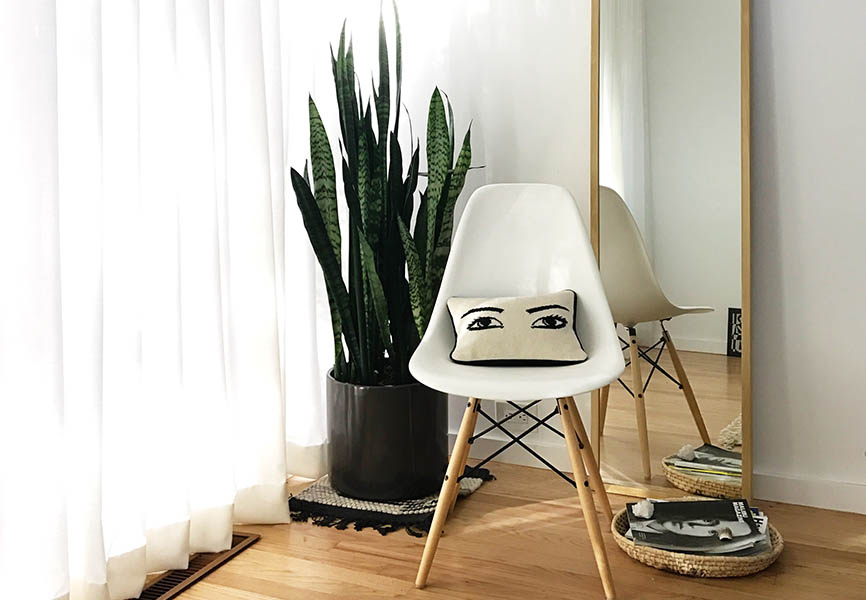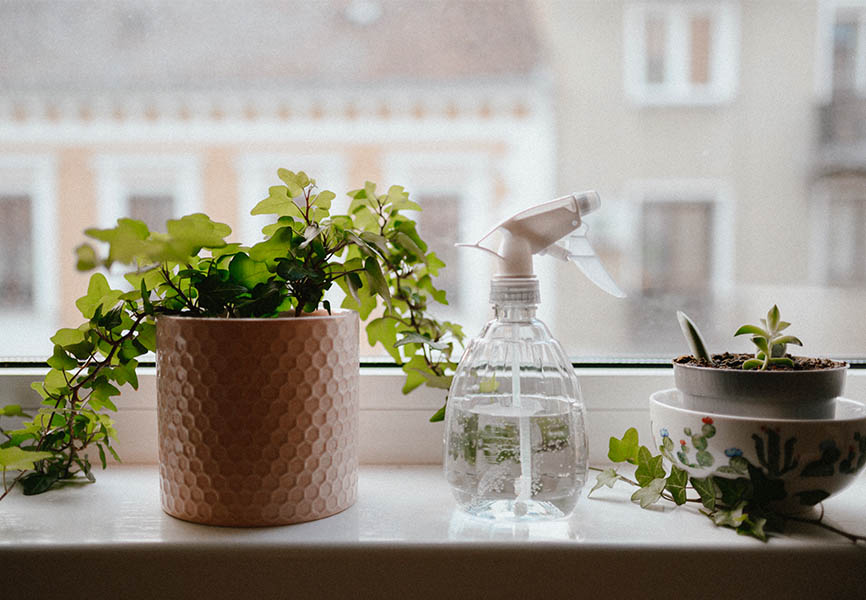HOW TO CARE FOR OUTDOOR PLANTS INDOORS
That undeniable chill in the air means it’s time to hunker down and head indoors for the colder months.
It also means your potted plants that relied on warm sunshine and rain all summer need a cozy place to crash, too. Before your favourite perennials and herbs succumb to the changing climate, follow these easy tips to give them the TLC they need to make it through.
The great indoors

Once the temperature dips to sweater weather, the tender container plants you brought outdoors in the spring need to make their way back inside. But not all plants can survive the shock of indoor growing conditions – especially if your home is dry and has a limited number of sunny spots.
In smaller spaces where big planters just aren’t practical, you’ll have to choose wisely:
• Keep only healthy plants. If something has been struggling all summer under the best of conditions, there’s a good chance it’s not going to improve indoors.
• Keep an eye out for pests or diseases. Problems actually spread more quickly among indoor plants since there are no natural predators of insects in the house. Check all plants thoroughly for any signs of trouble.
• Favour plants you've been coddling. Expensive splurges like a gardenia are worth the effort, too, if you have the room.
• If you can spare the space, consider bringing in your small pepper or tomato plants. These tropical perennials will continue to produce fruits all winter given enough light. Compact, patio variety cherry tomatoes and small-fruited peppers like chilies or cherry varieties will fruit easiest.
• Herbs like lavender, thyme and rosemary can survive indoors if they’re not overwatered, have plenty of drainage and get adequate sunlight. A windowsill is an excellent spot for individual pots.
Tip: Consider heartier plants and a plant light system if your home or apartment won’t provide enough natural light to keep plants happy.
NSFP (“not safe for pets”)

One more important factor to consider before deciding what plants to bring inside? Your super-loved, furry friends! Minto Apartments are pet friendly, so we know how important this step is.
• It’s true that not all plants are safe for animals, so while you think about what plants to transition from outdoor to indoor, get out your favourite plant app or search engine and figure out what’s safe for them.
• Plants like azalea, lilies, oleander, daffodils, lily of the valley, sago palm and tulips are poisonous to pets.
Don’t forget this step – it’s a crucial one!
Give them some time

One of the most important things you can do to ensure the health of your plants is to give them time to get used to their new environment. Especially given that many popular houseplants come from tropical areas and do especially well outside in the summer.
• Be sure to bring your houseplants indoors when you can still keep windows open and the temperature inside and out is roughly the same.
• Aim for at least two weeks before the first frost, which for many is somewhere between November 1-10 – so mid-October is ideal.
• They'll adjust more easily if the change is gradual, rather than waiting until a frost is expected and then bringing the plants into a dry, heated home.
Tip: Plants drink less with decreased light, so allow soil to dry out before the next watering.
Clip, clip hooray!

We know how hard it is to choose favourites, so if there’s simply not enough room to bring all of your plants inside, the next best thing is to take stem cuttings from a parent plant so you can enjoy it again next year.
• It’s as easy as taking a small 4-6 inch clipping, placing it in water until it develops roots and then planting it in a small pot.
o These instructions will show you how.
• Over the winter, you can hone your indoor gardening skills and take care of the little sprouts until they’re ready to be repotted for your deck or balcony in the spring.
Tip: It’s a good idea to use fresh soil when you’re repotting to be sure the insects that hitched a ride in summer don’t have a chance to winter indoors.
Spray away

A great tip from Dengarden to get houseplants ready to come inside for winter is to give them a good cleaning.
• With an organic insecticidal soap (or 1 tablespoon of dish soap to 1 litre of water), spray down both the leaves and soil until it’s fully saturated, let it sit for 15 minutes then rinse them off with fresh water in the shower.
• You can even completely dunk smaller potted plants in the mixture and swish them around to give it a top-to-bottom cleaning.
After you rinse off the dirt and debris, you’ll have a happy, bug-free houseplant that’s ready to spend the next few months inside.
Spot a plant temper tantrum

Plants are finicky and will let you know pretty quickly when things aren’t working for them. When you’re gardening inside, you don’t have Mother Nature to rely on to keep the perfect balance of sunshine and rain, so it’s up to you to spot problems before they get out of hand.
• Better Homes & Gardens has great tips to troubleshoot issues like browning, dropping leaves, yellow, pale or spotted leaves and general distress.
• Whether overwatering or underwatering, too little light or too much heat, indoor plants can be a test of patience – but well worth it if you can help them get through difficult times.
• You may also want to check out the ultimate houseplant care guide to help keep your plants healthy through to next year’s patio season.
Tip: Use a humidifier or mist your plants daily to combat the effects of your dry, heated home.
Gardening inside can be just as fulfilling as it is outdoors – so no matter what small space plants bring you the most joy, don’t give up on them when you’re preparing for fall and the colder, darker days ahead. With the right care (and maybe a little luck), they’ll be ready to join you outside again next spring.
Share your best plant care tips with us on social (@MintoApartments) – we’d love to hear them!